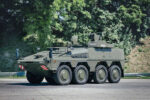German drone manufacturer Quantum Systems has acquired fellow German firm Spleenlab GmbH, a specialist in artificial intelligence for autonomous systems. The acquisition aims to accelerate the integration of advanced onboard AI capabilities into Quantum’s unmanned aerial vehicles (UAVs), with a clear focus on defense and intelligence-surveillance-reconnaissance (ISR) applications.
Strategic Acquisition Targets Onboard Autonomy
The acquisition of Spleenlab reflects Quantum Systems’ intent to consolidate its position as a leader in tactical UAVs with embedded artificial intelligence. Founded in 2018 and based in Saalburg-Ebersdorf, Germany, Spleenlab has developed proprietary software for edge-based sensor fusion and autonomous decision-making under its VISIONAIRY® product line. These technologies enable drones to process data from electro-optical/infrared (EO/IR), LiDAR, and radar sensors directly onboard without relying on cloud connectivity or ground station processing.
Such capabilities are increasingly critical for military operations where bandwidth is limited or contested. By embedding real-time AI at the edge—onboard the drone itself—Spleenlab’s solutions allow for faster threat detection, target classification, obstacle avoidance, and mission adaptation without human intervention.
Enhancing NATO-Grade ISR Capabilities
Quantum Systems’ flagship products include the Vector eVTOL fixed-wing drone and the Trinity F90+ mapping UAV. Both platforms are already deployed by NATO members and partner countries for ISR missions. The integration of Spleenlab’s VISIONAIRY® software is expected to significantly enhance these platforms’ ability to operate autonomously in GPS-denied environments or under electronic warfare conditions.
This is particularly relevant given recent battlefield experiences—such as those seen in Ukraine—where GNSS spoofing/jamming and signal degradation have become routine threats. Integrating onboard AI that can adapt sensor fusion logic and navigation algorithms dynamically will be a force multiplier for frontline ISR units relying on small tactical drones.
Sovereign Technology Stack Amid Geopolitical Pressures
Both companies emphasized that the acquisition strengthens Germany’s sovereign capability in dual-use technologies—those applicable across both civilian and military domains. In a joint statement released on October 21st 2025 via DroneLife and corroborated by multiple German defense outlets including ES&T (Europäische Sicherheit & Technik), Quantum Systems CEO Florian Seibel noted that “the future of unmanned systems lies not just in flight performance but in their ability to perceive, decide, and act autonomously.”
This move also aligns with broader European efforts to reduce dependency on non-EU tech stacks amid increasing geopolitical tensions with China and Russia. By internalizing key components like AI perception modules within Europe’s industrial base—and specifically within Germany—the acquisition supports strategic autonomy goals outlined by both the German MoD (BMVg) and EU Defence Fund initiatives.
Diverse Applications Beyond Defense
While defense remains a primary driver of the deal—especially given Quantum’s growing footprint among NATO clients—the companies also highlighted applications across civil security (e.g., disaster response), critical infrastructure inspection (e.g., pipelines/power grids), environmental monitoring (e.g., wildfire detection), and urban mobility research.
- Spleenlab’s VISIONAIRY® technology: Already tested with automotive OEMs for autonomous driving scenarios.
- Quantum’s Trinity platform: Used by forestry agencies across Europe for terrain mapping using multispectral sensors.
The convergence of these domains suggests that future iterations of Quantum drones could support multi-mission payloads capable of switching between civilian reconnaissance tasks and military ISR functions depending on operational needs—a key requirement for dual-use procurement programs gaining traction within EU institutions.
Technical Roadmap: Edge-AI Sensor Fusion at Scale
The immediate technical roadmap includes deeper integration between Quantum’s flight control systems—including GNSS-denied navigation—and Spleenlab’s neural network-based perception stack. This will likely involve retraining convolutional neural networks (CNNs) optimized for embedded GPUs such as Nvidia Jetson TX2/Xavier NX or ARM-based NPUs used in small UAVs.
Spleenlab’s software supports modular architecture compatible with ROS/ROS2 middleware standards—a critical enabler for interoperability across NATO-aligned platforms. This opens pathways toward STANAG-compliant C4ISR integration where real-time object detection/classification feeds can be shared over Link-16 or other tactical datalinks without requiring full uplink bandwidth.
Industry Impact & Competitive Landscape
The acquisition places Quantum Systems squarely within an emerging cohort of European drone OEMs pursuing vertically integrated autonomy stacks—alongside players like Parrot (France) with its Anafi USA platform powered by Pix4D analytics, or Teledyne FLIR integrating Boson thermal cores with onboard ML inference engines.
This trend reflects a broader shift away from reliance on U.S.-origin cloud-based analytics providers such as Palantir or Anduril when operating within European theaters constrained by GDPR compliance or strategic sovereignty concerns. It also positions Quantum competitively against Chinese-origin systems like DJI M30T—which have been increasingly restricted from government use due to cybersecurity concerns—even though DJI still dominates commercial markets globally.
Conclusion: Toward Smarter Battlefield Drones
The acquisition of Spleenlab marks more than just corporate consolidation—it signals a strategic pivot toward smarter battlefield drones capable of making decisions at machine speed under contested conditions. With NATO forces prioritizing resilient ISR assets that can survive EW threats while reducing operator burden through automation, this deal could serve as a blueprint for future MilTech integrations across Europe’s defense ecosystem.
If successfully executed at scale—with robust testing under operational conditions—the combined capabilities could redefine what small tactical drones can achieve autonomously over complex terrain under fire or electronic attack. For now, all eyes will be on how quickly this integration translates into deployable field upgrades across existing Vector fleets already operating along Eastern Flank borders—and potentially beyond.










